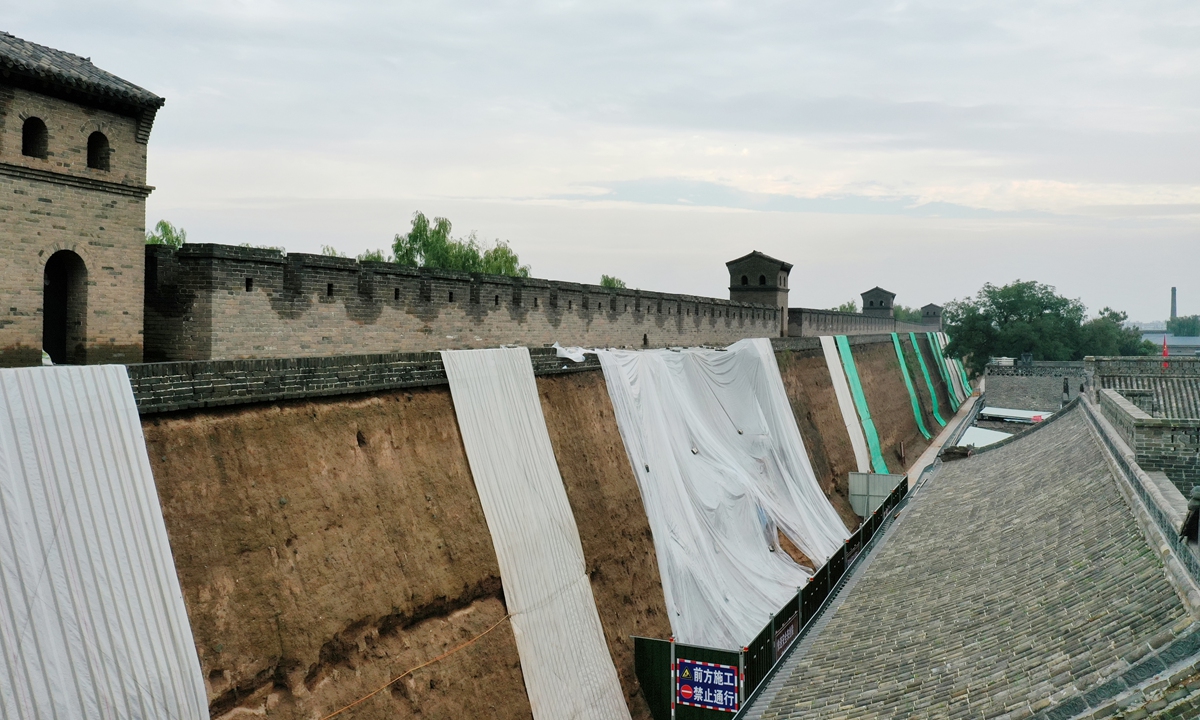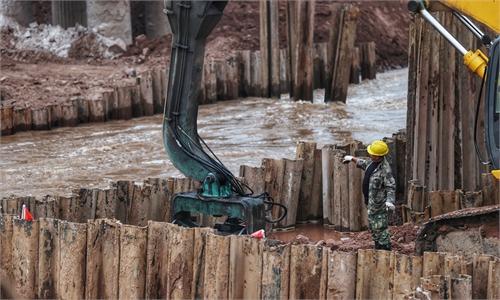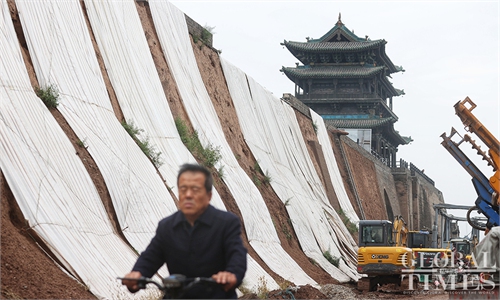
Repairs at flood-stricken Pingyao Ancient City in N.China's Shanxi Province are underway and the damaged walls will be restored to their original state, GT learned. Severe downpours damaged 51 sections of the ancient wall, including the collapse of 15 sections of rammed-earth interior walls. Photo: Cui Meng/GT
Rescue and repair work for flood-stricken Pingyao Ancient City in North China's Shanxi Province is underway, and the plan is to make sure that damaged ancient walls are restored to their original state, the Global Times learned at the site on Thursday.
Recent severe downpours damaged 51 sections of the ancient wall, including 15 sections of rammed-earth interior walls.
The Global Times saw at the scene that the collapsed walls this time were mainly located in the east city, and the walls were covered with tarpaulins after emergency treatment. To protect the rest of the wall from damage or collapse, many remaining areas of the rammed-earth interior wall of the ancient city have been covered with tarpaulins.
Experts assured the public that the damaged sections would not cause great damage to the ancient wall as a whole. But to ensure safety, the ancient wall is closed to visitors for now.
To speed up the repairs and minimize the damage caused by the heavy rain to the ancient city wall, Pingyao will start the construction work while experts discuss the maintenance plan. The National Cultural Heritage Administration has sent experts and allocated funds to help with the repair work.
Repairs will prioritize the worst-hit parts, Shao Shuai, a technical expert from Pingyao's cultural relics institute, told the Global Times on Thursday.
It is a handover from the Ming Dynasty (1368-1644) that the outer wall of the Pingyao Ancient City is built with bricks and the interior wall with rammed earth. Shao said to protect the ancient city and its original architecture, Pingyao would not immediately adopt reinforcement plans, but experiments of adjusting the formula of the rammed earth so as to reinforce the city wall are underway.
These might include blending different proportions of ash in the rammed earth, or adding glutinous rice juice or aggregates. "In the Ming Dynasty, adding glutinous rice juice to the soil was the high treatment that some royal buildings would have," Shao said.
But this experiment will be a long-term one. It is necessary to continuously monitor the experimental data and see whether the adjusted rammed-earth sections can withstand years of wind and rain, the expert said.
To protect the ancient wall and leave the ancient city with its original look as in the Ming Dynasty, Pingyao won't use bricks on the interior wall, which could be vulnerable in a severe downpour.
To ensure the timely detection of any danger, local departments are making more frequent patrols, which are held once every two hours. Any earth fall-off, deformation, crevice, or ant colony will be examined and recorded, Shao told the Global Times.
Tarpaulins have been used to cover some fractions of the ancient wall that are susceptible to danger in every rainy season around May. About 200 such tarpaulins were used before this downpour reached Pingyao, and as rainfalls continued, another 200 were used, he said.
Apart from the Pingyao Ancient City, the recent heavy rainfall has affected many ancient buildings and cultural relics in Shanxi. Roof leaks appeared in several ancient buildings in Jin Temple, the most prominent temple complex in Shanxi, while the Tianlongshan Grottoes, caves notable for the Buddhist temples located within them, shared a similar situation.
Shanxi Province is known for its ancient buildings preserved until the present day, and renowned as "the museum of Chinese ancient architecture." The total number of registered unmovable cultural relics in Shanxi has reached 50,000, including 28,027 ancient buildings, data showed.



